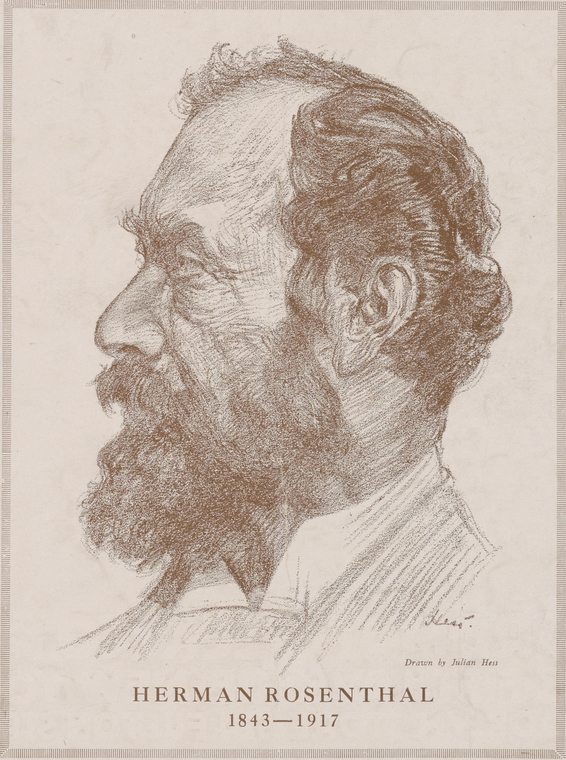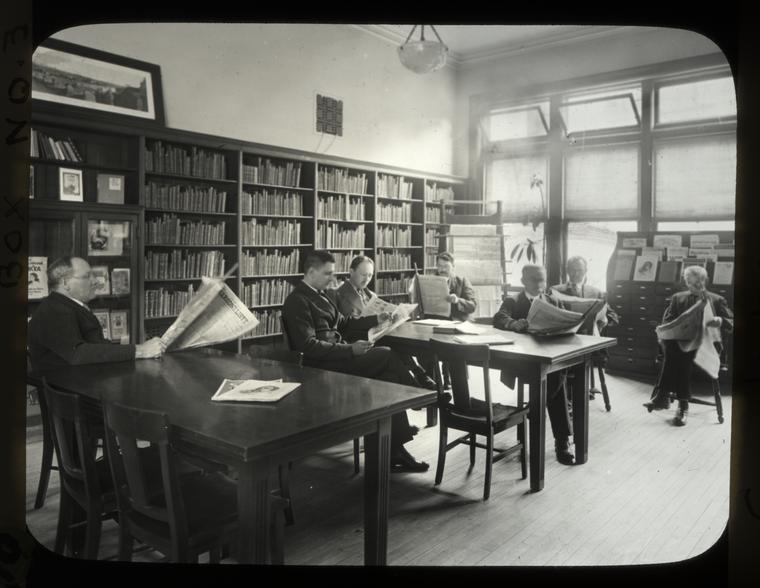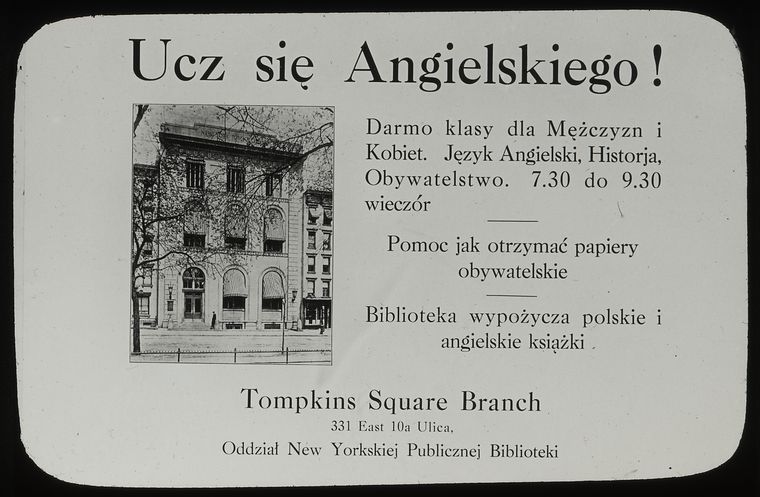A Brief History of Slavic and East European Collections at the New York Public Library
Some of the Slavic and East European materials held by the New York Public Library have their acquisition origins linked to the NYPL's predecessor institutions, namely the Astor Library (established in 1848) and the Lenox Library (established in 1870). Joseph Green Cogswell (1786-1871), the first Astor librarian, noted the existence of a modest collection of Slavic and Hungarian vernacular literature within the library's holdings, which included both retrospective and contemporary Rossica – works printed either in Latin or Western European languages concerning or originating from Russia. The Lenox Library contributed most significantly to the Slavic and East European collections of the future New York Public Library in the area of western Slavic and Baltic vernacular Bibles and liturgical works.
In 1899, the Library responded to the request of New York's Russian-speaking community by establishing a separate Russian Department whose holdings grew during its first year to 1,300 volumes. Under the leadership of Herman Rosenthal (1843-1917), its first chief (1899-1917), the department's mission quickly expanded to encompass materials from all Slavic countries. Consequently, its name was changed to the Slavonic Department, and later in 1911, to the Slavonic Division. Rosenthal, supported by the first director of The New York Public Library, Dr. John Shaw Billings (1838-1913), established formal exchange relations with numerous learned societies in Eastern Europe. Additionally, Rosenthal engaged Slavic-language booksellers in New York and actively sought donations from individuals interested in the region. This concerted effort ensured the department's growth and access to a wide range of Slavic materials.
On May 24, 1911, at 9:15 a.m. David Shub (1888-1973) requested a book by the Russian philosopher Nikolai Iakovlevich Grot (1852-1899) Nravstvennye idealy nashego vremeni [(Moral Ideas of Our Time: Friedrich Nietzsche and Leo Tolstoi] (1894) making it the first item delivered to a reader in the newly opened central building of the library. By 1917 the collection of the Slavonic Division grew to some 25,000 vernacular-language volumes and the readership to almost 20,000 people a year.
During its initial two decades, the primary focus of collection efforts was on acquiring current monographs and periodical backfiles. However, a notable number of older and antiquarian monographic titles were also procured during this period. The Division maintained its focus on establishing a comprehensive research collection, typically acquiring materials commonly found in academic institutions. Concurrently, the branch libraries catered to the popular interests of the city’s Slavic, Baltic, and East European readership.
By 1913, the circulation of Russian and Czech-language books in the branches had surpassed 500,000 volumes for each language group. Notably, the Webster Library distinguished itself among branches by serving as the designated Czechoslovak branch, boasting around 15,000 Czech and Slovak volumes by the early 1920s. Significant East European collections, encompassing Russian, Polish, Ukrainian, Hungarian, and other languages, were housed in various branches, particularly at locations such as 96th Street, Columbus, Hamilton Fish Park, Melrose, Ottendorfer, Rivington Street, Seward Park, Tompkins Square, and Tremont. However, as immigrants assimilated into American society and the demand for lending vernacular-language collections waned, the Slavonic Division gradually absorbed some of these circulating vernacular-language collections, while others were relocated to The World Languages collection at the Donnell Library.
During the 1920s and 1930s, the Library's Slavic and East European collections experienced significant growth. Avraham Yarmolinsky (1890-1975), who served as the head of the Slavonic Division from 1918 to 1955, and Harry Miller Lydenberg (1874-1960), Chief Reference Librarian from 1908 to 1927 (later the director of the NYPL), embarked on a book-buying expedition to Eastern Europe, primarily focusing on Soviet Russia. This trip took place at the turn of 1923 and 1924 and resulted in the acquisition of approximately 9,000 volumes comprising both retrospective and contemporary books and periodicals.
From 1925 to 1935 the Library was also acquiring books from Israel Perlstein (1897-1975), America’s premier dealer of Russian antiquarian materials, who made numerous book-buying trips to the Soviet Union. He obtained and sold to American libraries in quantities often remarkable materials offered for sale by the Soviet government. In 1931, the NYPL obtained some 2,650 volumes of Russian Imperial family materials which constituted the single largest purchase of that type of material.
Beginning in the early 1920s the Library began to acquire triple-oversize or elephant folio plate books—principally Russian—produced during the nineteenth and the early twentieth century. During the 1930s and the 1940s. Church Slavonic collections grew significantly. In 1931 alone, the Library purchased seven printed Cyrillic books of the sixteenth and seventeenth centuries. The largest cluster of illuminated manuscripts was purchased in 1948/1949.
Materials added to the collection during World War II primarily consisted of those published before 1939, as the conflict effectively halted the intake of current materials from their respective homelands. Following the victory in Europe, there was a glimmer of hope for new acquisitions. However, the Sovietization of Central and Eastern Europe, coupled with export restrictions during the Cold War, proved to be as devastating to the acquisition process as the war itself. Despite these challenges, it was during this tumultuous period that the Slavonic Division displayed an intensified interest in the non-Russian peoples of Central and Eastern Europe. As a result, numerous successful efforts were made to procure materials in the languages of these nations.
Despite the acquisition challenges faced during World War II and the initial years of the Cold War, Yarmolinsky’s retirement in 1955 marked the conclusion of a period of unparalleled growth in the collections of both Slavic and, particularly, Russian vernacular and Rossica materials at the NYPL. By that time, the collections had grown to encompass a hundred thousand volumes, with three-quarters of them in Russian. In 1948, the NYPL's Russian collection was esteemed as one of the "Big Five" in the United States. Just two years later, it earned recognition as second only to the Library of Congress in both the quantity and quality of its Russian materials.
During the Yarmolinsky era, the readership included numerous prominent figures, among them Russian Social Democrat Leon Trotsky (1879-1940), White General Anton Ivanovich Denikin (1872-1970), and the renowned writer Vladimir Nabokov (1899-1977), to name just a few.
In 1956, John Leo Mish (1909-1983) assumed the role of the head of the Slavonic Division. His tenure was marked by a strategic shift in resource allocation, aiming to curtail expenditures on Russian materials while enhancing investments in materials across other Slavic and Baltic languages. Additionally, Mish prioritized re-establishing connections between the Library and institutions in East-Central Europe. Reciprocal agreements with libraries, universities, and research institutes in the Slavic and East European regions were instrumental in fostering the expansion of the Library’s collections in their respective languages, a trend observed since its inception and enduring until the collapse of the Soviet bloc. At its zenith, the library fostered exchange relationships with approximately 195 institutions in the region.
In 1976, when Estonian-born classicist and philologist Viktor Kõressaar (1916-2002) assumed the role of Chief of the Slavonic Division, the city teetered on the brink of bankruptcy. During this financially challenging period, the Library prioritized current materials over rarities.
However, a significant shift occurred in the mid-1980s when the division resumed antiquarian purchases alongside regular acquisitions, thus enriching the basis for research. From 1984 to 2009, under the curatorship of Edward Kasinec, the division spearheaded the identification of rare Slavica in other units, including materials procured from the libraries of the Romanov family. Substantial federal and state funding was secured for the physical conservation of older materials and the digitization of thousands of visual resources. Numerous catalogs, checklists, and articles detailing various aspects of the collections were meticulously prepared and published. The division hosted several major exhibitions of Slavic and East European holdings, alongside numerous smaller exhibitions, seminars, and lectures. Noteworthy antiquarian acquisitions and valuable gifts were received during this period, including the notable addition of the 14th-century Mol[i]tvʹnikʹ [Euchologion], the second oldest Slavic manuscript in a public collection in North America.
After the integration of the Slavic and Baltic Division into the General Research Division, the Library has continued to expand its holdings in Slavic and East European materials. This endeavor has been closely coordinated with Columbia, Princeton, and Harvard Universities, utilizing a collaborative collection development model centered around ReCAP, the shared offsite storage facility of the four institutions. Currently, the NYPL holds close to half a million volumes in Slavic and East European languages, with a comparable number of titles on the region published in other languages.







